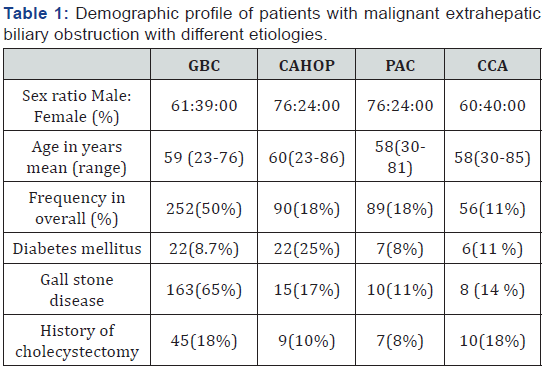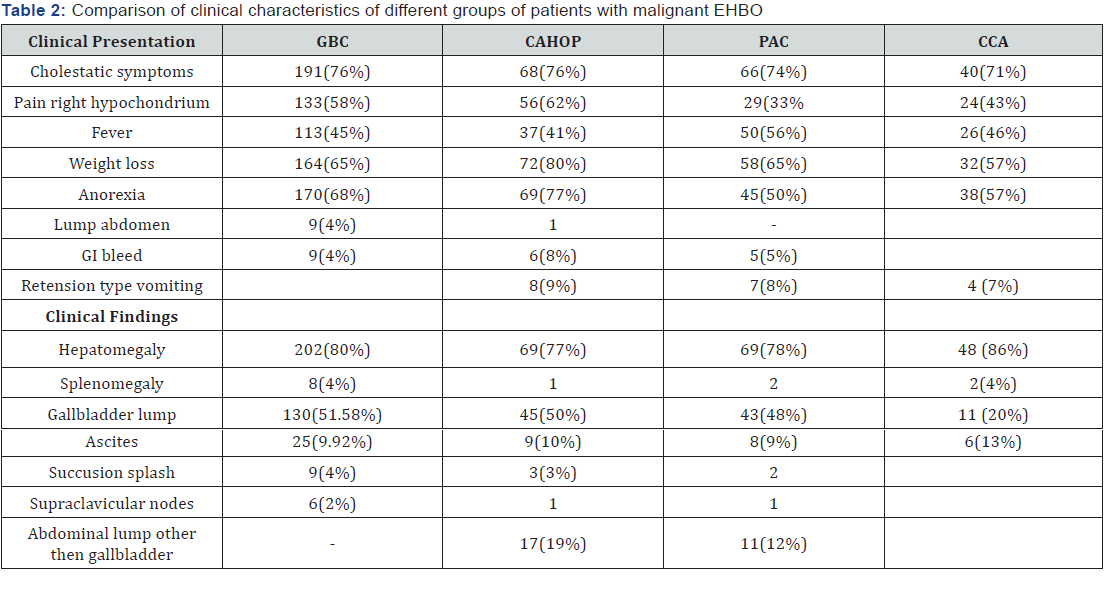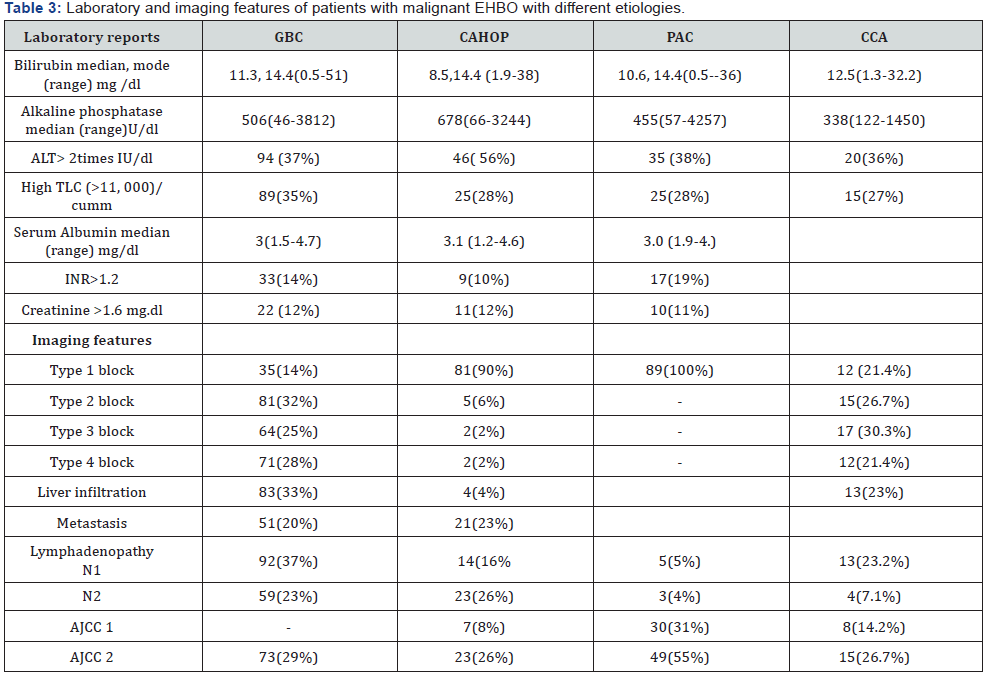Profile of Malignant Extrahepatic Biliary Obstruction at an Indian Tertiary Care Centre: A Dismal Picture
Vijay Sharma1*, Gourdas Choudhuri2, Richa Sharma3 and Vivek Anand Saraswat2
1Departments of Gastroenterology, Manipal Hospital, India
2Department of Gastroenterology, Sanjay Gandhi Postgraduate Institute of Medical Sciences, India
3Department of Public Health, Regional Institute of Health, India
Submission: December 06, 2016; Published: January 19, 2017
*Corresponding author:Vijay Sharma, Departments of Gastroenterology, Manipal Hospital, 170-B, Indira Colony, bani park, Jaipur 302016, India, Tel:0141-4019159,+91-9928015254;Email: vijaysadashiv@gmail.com
How to cite this article: Vijay S, Gourdas C, Richa S, Vivek A S. Profile of Malignant Extrahepatic Biliary Obstruction at an Indian Tertiary Care Centre: A Dismal Picture. Adv Res Gastroentero Hepatol 2017; 2(4): 555591. DOI: 10.19080/ARGH.2017.02.555591
Abstract
Background and aims:Malignant EHBO is a common condition seen by gastroenterologist. There is scant data from south Asia about demography, clinical, laboratory, imaging & endoscopy features of patients with malignant EHBO.
Material and Methods:We retrospectively analyzed our six year data. Diagnosis was based on imaging with cytological confirmation. Statistics used was percentage, median and range for Parametric data
Results:We retrospectively analyzed our six year data. Diagnosis was based on imaging with cytological confirmation. Statistics used was percentage, median and range for Parametric data
Conclusions:GBC (46%) is most common cause of malignant EHBO in North India. Most patients of malignant EHBO except PAC presents in advanced stage. Palpable gallbladder present in nearly 50 % of cases, while cholangitis present in one third of the patients.
Keywords:Extrahepatic billiary obstruction; Gallbladder carcinoma; Pancreatic carcinoma; Periampullary carcinoma; Cholangio carcinoma
Abbreviations:: GBC: Gallbladder Carcinoma, CAHOP: Carcinoma Head of Pancreas, PAC: Periampullary Carcinoma, CCA: Cholangio Carcinoma, EHBO: Extra Hepatic Billiary Obstruction
Introduction
Hepatitis C virus (HCV) infection almost 3% of the world’s population [1]. Almost 70% infected patients get chronic hepatitis while around 30% express complete recovery [2]. The pathogenicity of viral infections are highly predisposed by the host immune response. Immune systems of the body eradicate several viruses at their acute stage, Though HBV (hepatitis B virus) and HCV (hepatitis C virus) develop persistent infection the host immune systems and develop persistent infection [3]. Interleukin 12 (IL-12) is a 70-kilo Dalton hetero-dimer protein, comprised of p40 and p35 subunits.These subunits are encoded by two separate genes present on two different chromosomes [4]. IL-12 performs its role as a linkage among the innate and the adaptive immune reactions and also a perilous part in immune pathogenesis of numerous ailments [5]. IL-12 expresses antiviral role as an activator of NK cells, inducer of interferon , and cytotoxic lymphocytes. These all factors are vital part of anti-HCV immune responses [6]. IFN- stimulation results the production of antigen which causes the creation of pro-inflammatory cytokine IL-12 [7]. Therefore IL-12 is considered as a distinct Th1 and Th2 differentiation determining factor [8]. Therefore this study was intended to explore the expression of IL-12 with hepatitis C infestation in Interferon responders and non-responders and to assess their possible role as new biomarker for the treatment response. drainage in case of high bilirubin ( >20mg/dl) or cholangitis. We analyzed our last more than six years data by reviewing inpatient files of patients with collection and analysis of complete data.
Methods
Data was collected over six years data of patients with malignant EHBO admitted to our hospital. Most of the patients were diagnosed on the basis of ultrasound, which also revealed type of block, extent of disease, liver and lymph node metastasis. In patients with no clear documentation of advanced disease on ultrasound Compound tomography (CT) abdomen was also done for staging. Cytological confirmation by USG guided fine needle aspiration cytology or endoscopic versus percutaneous biliary brushing. FNAC from lymph nodes and ascitic fluid cytology revealed malignant spread (Table 1).

Results
On analysis of data Gallbladder carcinoma (GBC) was the most common etiology for malignant EHBO in our patients, it was diagnosed in 252 (50%) of patients, while other etiologies were carcinoma head of pancreas (CAHOP) in 90(18%), periampullary carcinoma (PAC) in 89(18%), cholangiocarcinoma (CCA) in 56 (11%) and remaining 17(3%) patients having biliary obstruction due to metastatic malignancies (carcinoma stomach 5, carcinoma breast 3, hepatoma 2, carcinoma colon 2, lymphoma 2, cancer of unknown primary 3). Mean age of the 505 patients studied was 58 years +/_ nine years (age range 24-85 years). It was comparable among all the groups. Two hundred eighty seven (57%) were male, and 218 (43%) were female, the ratio of male:female was 1.32 : 1.00. While in different groups male: female gender ratio were 1.00:1.56 in GBC, 3.16:1.00 in CAHOP, 3.16:1.00 in PAC and 1.50:1.00 in CCA.
Presenting symptoms were jaundice 468(93%), pruritus 362 (72%), weight loss 300(60%), anorexia 320(64%), pain right hypochondrium (RHQ) 256(51%), gastrointestinal bleed in the form of hematmesis and melena 20 (4%) and vomiting in 19(3.7%). On comparing presenting symptoms of different etiologies we observed that cholestatic symptoms were comparable (more than three fourth of the patients) between different groups, while pain in RHQ was more common in GBC and CAHOP then in PAC and CCA patients. Fever as presenting complaint was more common in PAC compared to others suggestive of higher incidence of cholangitis. Icterus was present in nearly 98% of the patients in all groups, hepatomegaly was present in more than three fourth of the patients. Palpable gallbladder lump was less common in CCA. We observed that associated diseases like diabetes mellitus was most common with CAHOP then with other etiologies. History of cholecystectomy was present more commonly present in GBC and CCA. Laboratory reports revealed that High white blood cell count (> 11, 000/cumm) suggestive of cholangitis was present most commonly in GBC then other groups of patients. Abnormal Liver function tests as high median bilirubin was 12.2 mg /dl (range 1.2-36 mg /dl, normal < one mg/ dl); serum alkaline phosphatase 1108 IU/dl ( range 118-6280 IU/dl), raised SGPT (>two times) was present most commonly in CAHOP. Imaging studies revealed that all patients with CAHOP & PAC were having type one biliary block (lower end involvement) , while in GBC & CCA type 3 block ( involving confluence) and type 4 block ( separation of confluence ) was present in nearly two third of the patients. Advanced American joint committee for cancer (AJCC) stage three and stage four were diagnosed in two third of the GBC and CCA patients. Liver infiltration was present most commonly in GBC. Gall stones were present most commonly in association with GBC then other etiologies. Upper gastro intestinal endoscopy demonstrated growth or infiltration in 87(22%) of malignant EHBO patients. Only 15(5.93%) GBC patients could be referred for surgery, while 52 (21%) underwent percutaneous transhepatic drainage (PTBD) and self expandable metal stent (SEMS) placement, 17(seven %) underwent endoscopic biliary drainage and SEMS placement, 44(17%) underwent endoscopic biliary drainage and plastic stenting, 139 patients either declined any intervention or they were having advanced disease or had poor performance status, and thus not amenable to any form of therapeutic intervention.
In CAHOP group 30 patients (33%) underwent surgery, nine patients(10%) underwent PTBD & SEMS placement, one patient died post PTBD, 40(44%) underwent ERCP and SEMS placement , 34(43%) ERCP and plastic stenting (most were presurgical drainage), three patients underwent endoscopic papillotomy and biopsy and remaining patients declined any intervention.
In PAC group all patients were referred for surgery, but 14 patients declined any treatment, 5 preferred PTBD & SEMS. Endoscopic biliary drainage and plastic stenting was done in 51(57%), only endoscopic papillotomy in seven patients.
In CCA group 16 (29%) referred to surgeons, 12(21%) underwent PTBD and SEMS placement, 11(20%) underwent ERCP and plastic stenting and four patients underwent endoscopic SEMS placement followed by intraluminal brachytherapy.
Discussion
The present study has highlighted the fact that malignant EHBO is predominantly a disease of middle aged people with predominantly male population. Present study revealed that GBC was the most common etiology for malignant EHBO in our patients (50%), while other etiologies were CAHOP (18%), PAC (18%), and CCA(11%). Our data is different compared to other study published from India in which on ultrasound evaluation malignant EHBO was much more common than benign causes (75.3% Vs. 24.7%) with Gall Bladder Carcinoma constituting (28.7%), Carcinoma Pancreas (26.5%), Cholangio Carcinoma (10.8%) and Ampullary Carcinoma (9.8%) [1]. Likely it reflects different epidemiological profile and referral pattern of our patients.
While comparing patient groups with different etiologies for malignant EHBO, we observed that GBC is predominantly a disease of middle aged female (mean age 59 years), who present with jaundice, weight loss, anorexia, pain RUQ, hepatomegaly, gallbladder mass and fever. This constellation of clinical features is similar to that reported from India [2-4] and other countries [5,6] except presence of gallbladder mass and history of fever which is more common in over patients which likely reflects delayed presentation and late referral to our centre.
These finding emphasize teaching by Strauch et al. [7] that GBC should be suspected in an elderly women with a history of biliary complaints, who present with a change in the frequency and severity of pain or a mass in the right hypochondrium or develops hepatomegaly. These findings are invariably associated with advanced disease and cannot be relied on for screening population or for detecting early disease. In the present study, the number of patients with GBC having associated gallstones on imaging was 65%, which is comparable to other studies [4,8]. Gallbladder cancer is the most common cause of malignant obstructive jaundice, especially women in the northern part of India [9].
The majority of our patients with GBC (71%) presented with advanced disease (stage three and stage four). It is comparable to other series from India where incidental GBC was diagnosed in 2% of patients3 and different from western series revealing stage I 26.4%, stage II 5%, stage III 28.8% and stage IV 39.8%. Our study shows that CAHOP is predominantly a disease of middle aged male, who present with weight loss, anorexia, jaundice, hepatomegaly, gallbladder mass, pain RUQ, fever, and ascites. This constellation of clinical features is slightly different from western data reporting that 57% of patients were male and they presented with abdominal pain (64%), Jaundice (57%,) weight loss (48%), vomiting (30% )and back pain (26%) in the palliated group compared to abdominal pain (36%), jaundice (72%), weight loss (43%) in resected group. [10] It is possibly due to delayed presentation to our hospital, delayed referral, lack of awareness among general practitioners and gender bias in presentation to hospital and getting treated for malignancy. In our patients with CAHOP AJCC stage one which has best respectability and results was present in 8 % of the patients, large series have shown that only 5-22% are resectable. History of new onset diabetes mellitus diagnosed in quarter of our patients which in various studies has been reported to be 6-68% [11-13]. Periampullary tumors have a high incidence among digestive neoplasm. Their overall prognosis is very poor, mainly due to the fact that cancer of the head of pancreas is the most frequent tumor in the group. In our series PAC is mainly a disease of male in their 6th decade, these patients presented with Jaundice, weight loss, fever, abdominal pain, hepatomegaly and cystic gallbladder lump. It is comparable to western series literature [14] where clinical presentation with jaundice (80%), pain abdomen (50%), hepatomegaly, palpable gallbladder and occult gastrointestinal bleed (33%) are present. Nearly all of our patients with PAC were resectable except four % of the patients who were having lymadenopathy of celiac, superior mesenteric and paraaortic groups of nodes. Carcinoma of extrahepatic bile duct remains a difficult clinical problem. Because experience with these tumors has been limited to a small number of centres, meaningful clinical trials have been difficult to perform, there is scant data on CCA from India, mainly in the form of abstracts, there is no published series from India, 11% of patients with malignant EHBO in our series were diagnosed to have CCA, predominantly disease of male in 6th decade, 62% of CCA were hilar CCA, while 38% were distal bile duct carcinoma, which is comparable to western data. As our patients presented in advanced stage of disease clinical findings were more obvious in present series, same is applicable to fever which is more significantly reported then other series it shows delayed referral of patients and many patients referred after biliary procedures. While in western series pain RUQ, anorexia, weight loss and pruritus are present in only one third of the patients, while fever is rarely the presenting symptom [14,15] (Table 2&3).


Conclusion
It is the first study from single centre describing large group of consecutively admitted of patient with malignant EHBO. GBC (46%) is the most common cause of malignant EHBO in North India. Most patients of malignant EHBO except PAC presents in advanced stage of disease due to delayed medical consultation and possibly delayed referral. There was high incidence of palpable gallbladder mass in GBC & CAHOP, cholangitis was more common in GBC, and high frequency of higher billiary block was detected in CCA and GBC.
Acknowledgment
We are thankful to gastroenterology department faculty members, resident doctors and staff. We are thankful to endoscopy staff, gastrosurgery department faculty and radiology department faculty also staff for their help and support.
References
- Piehler JM, Crichlow RW (1978) Primary carcinoma of the gallbladder. Surg Gynecol Obstet 147(6): 929-942.
- Vattinen E (1970) Carcinoma of the Gallbladder A study of 390 cases diagnosed in Finland 1953-67. Ann Chir Gynaecol Fenn Suppl 168: 1-81.
- Strauch GO (1960) Primary carcinoma of the Gallbladder: presentation of seventy cases from the Rhode Island Hospital and a cumulative review of the last ten years of the American literature. Surgery 47: 368-383.
- Dutta U, Garg PK, Kumar R, Tandon RK (2000) Typhoid cARGHiers among patients of gallstones are at an increased risk for carcinoma of Gallbladder. Am J Gastroenterol 95(3): 784-787.
- Kar P, Kumar R, Kapur BM, Tandon BN, Tandon RK (1986) Surgical obstructive jaundice in India: a clinical profile. J Assoc Physicians India 34(2): 115-118.
- Sohn TA, Lillemoe KD, Cameron JL, Huang JJ, Pitt HA, et al. (1999) Surgical palliation of unresectable periampullary adenocarcinoma in the 1990s. J Am Coll Surg 188(6): 658-666.
- Warshaw Al, Fernandez-del Castillo C (1992) Medical progress Pancreatic carcinoma. N Engl J Med 326: 455-465.
- Rosenberg JM, Welch JP, Macaulay WP (1985) Cancer of the head of the pancreas: an institutional review with emphasis on surgical therapy. J Surg Oncol 28(3): 217-221.
- Singh SM, Longmire WP Jr, Reber HA (1990) Surgical palliation for pancreatic cancer. The UCLA experience. Ann Surg 212: 132-139.
- Nakeeb A, Pitt HA, Sohn TA, Coleman J, Abrams RA, Piantadosi S et al. (1996) Cholangiocarcinoma a spectrum of intrahepatic, perihilar, and distal tumors. Ann Surg 224(4): 463-473.
- Pitt HA, Doodley WC, Yeo CJ, Cameron JL (1995) Malignancies of the
biliary tree. Curr probl Surg 32(1): 1-90.
- Sarih M, Bouchrit N, Benslimane A (2000) Different cytokine profiles of peripheral blood mononuclear cells from patients with persistent and self-limited hepatitis C virus infection. Immunol Lett 74( 2): 117-120.
- Gigi E, Raptopoulou-Gigi M, Kalogeridis A, Masiou S, Orphanou E et al. (2008) Cytokine mRNA expression in hepatitis C virus infection: TH1 predominance in patients with chronic hepatitis C and TH1-TH2 cytokine profile in subjects with self-limited disease. J Viral Hepat 15(2): 145-154.






























